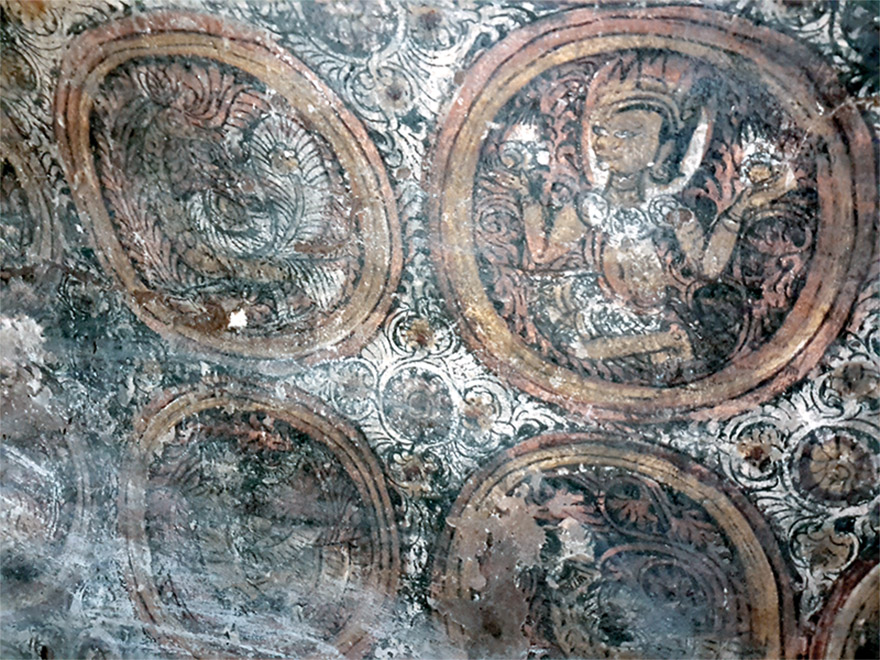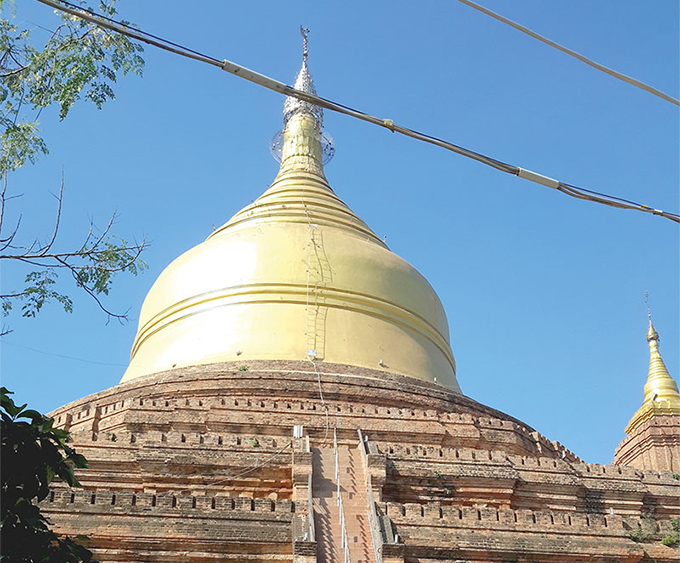By Maung Tha (Archaeology)
Kyaukse Township on 725.28 square miles of land is sharing border with Ywangan and PyinOoLwin townships in the east, TadaU Township in the west, Myittha Township in the south and Singaing Township in the north.
Currently, Kyaukse Township is constituted with one town, 10 wards and 223 villages of 87 village-tracts. Among 220 stupas and temples, Tamoke Shwegugyi, Shwetheindaw, Shwehsatthwar, Shwemuhtaw and Shwethalyaung are famous in Kyaukse Township. On reaching Kyaukse, travellers can pay visits to three ancient cities namely Pinle, Makkhaya and Myinsaing.
Pinle or Mongmaw
Among significant Pyu city states such as Sri Kestra, Beikthanoe, Hanlin, Watee and Tagaung, Pinle city was positioned in Myittha Township of Kyaukse District.
The outermost and innermost walls of Pinle city were in circular shapes and the middle one in a rectangular shape. The diameter of the outer wall was 1.8 miles from the east to the west and 1.6 miles from the south to the north. The whole wall was 5.5 miles in length and it took position on 222 acres of land.
It was assumed that Pinle was established in the 2nd century AD. The new history of Chinese Tang dynasty compiled by U Yi Sein mentioned nine guard towns of Sri Kestra were Hsipaw, Kanthita, Myingyan, Mweyin, Halin, Thepon, Taungdwingyi, Htigyaing and Htumin, and Htumin meant Mongmaw. Htumin, located on China-Pyu-India trade route, was the largest city among ancient cities in Kyaukse plain.
As coins, stings of black and white beads called Chin beads, elephant statues, cow statues, stings of beads, and bricks with marks were unearthed around Pinle city, it was known that a Pyu culture of the city was not later than those of Sri Kestra, Beikthanoe and Hanlin cities.
Baked earthen reliefs
Baked earthen reliefs discovered at No. 20 mound in ancient Pinle city were not similar in sizes and pictures. The first kind of coins bore a person holding a royal dagger rides a lion with floating two ends of his shawl from chest into air. The relief tablet was 13 inches long and 13 inches wide with 3.5 inches thick. A total of 18 tablets were found in good condition and 19 broken ones.
The second type of relief, 12 inches long and 12 inches wide with four inches thick, depicted head and chest of the standing lion in detail and its mane in floral works. Nine reliefs in good conditions were found together with 20 broken ones.
A total of 13 broken pieces in the third one was not found in good conditions. If the relief tablet was in good conditions, it would be 16 inches long, 14 inches wide and three inches thick. The relief portrayed a human riding an animal like tiger and he wore a turban at his head.
The fourth one was small reliefs with 7.5 inches long, 7.5 inches wide and two inches thick. Floral works were created under four legs of the animal like lion, and its neck was filled with dots. Two reliefs were excavated in good conditions together with two broken ones.
Mekkhaya
Mekkhaya, 413 miles from Yangon and 21 miles from Mandalay, an ancient city in Kyaukse region, is positioned in Singaing Township. Equipment and weapons in Stone Age and Pyu era were found in Singaing Township.
New Twinthin Myanmar history mentioned after three Shan brothers had arrested King Kyaw Swa of Bagan (1287-1298 AD) in 1298, eldest brother Razathingyan ruled Myinsaing, younger brother Athinkhaya in Mekkhaya and youngest brother Thihathu in Pinle. Mekkhaya was established in 666 ME when King Saw Nit (1298-1325 AD) ruled Bagan in 1304 AD.
Mekkhaya in Bagan era
As King Anawrahta of Bagan established towns to recruit soldiers ranging from 10 to 100,000 in addition to 43 guard towns including Mekkhaya together with Taohn and Myittha in Singaing Township. Guard towns were assigned to check entrance and exit of people in rural and remote areas from the Royal Palace and to levy taxes over the commodities. Mekkhaya was assigned to block Myitnge valley where enemy might enter Kyaukse plain.

The history written by veteran historian Dr Than Tun mentioned salient points of Mekkhaya city. It stated Mekkhaya land with its border lines.
The outer wall of ancient Mekkhaya city was two furlongs long from the east to the west and 2.5 furlongs long from the north to the south. Since its establishment, Mekkhaya was surrounded by a 56 feet wide moat. Mingala gate was built at the eastern wall. Mekkhaya city was designated as ancient cultural zone in January 2009.
Weapons of Palaeolithic and Neolithic ages were found in Mekkhaya region. Stone Age weapons were also found at pagodas in the precinct of Yazagyi in the northwest of the city and around Shinpin SeikU pagodas. Pieces of stone weapons in Neolithic ages were found there, one furlong north of Epya Village leading to Mekkhaya city.
Research findings of researcher Taik Kyi (Singaing) mentioned stone inscriptions of Sikhon Monastery and inscriptions on donation ceremony of the mason among 22 stone plaques were found in Singaing Township.
Works and equipment in the Stone Age and Pyu era proved Mekkhaya had been flourishing from the Stone Age to Pyu, Bagan, Pinya, Inwa and Konbaung eras.
Myinsaing in the history
Visitors can observe old walls, Thintwe Canal and some tunnels decorated with mural paintings in Myinsaing, four miles from Kyaukse of Mandalay Region.
In the history, King Narapatisithu of Bagan conferred Athinkhaya, Razathingyan and Thihathu titles on three sons of Theingabo and ordered Theingabo to govern Myinsaing Village. King Kyaw Swa ordered Athinkhaya to govern Myinsaing, Razathingyan to Mekkhaya and Thihathu to Pinle. Three brothers lured the king to Myinsaing and then dethroned him. While in Myinsaing, Bagan King Kyaw Swa built a Buddha image gazing Bagan from a hillside. Currently, the Buddha image remains just a mound but its head can be seen at the hillside.
At that time, four Chinese generals led the troops leading to Myinsaing. They arrived at Myinsaing on 25 January 1301. As three brothers showed the head of Bagan King Kyaw Swa after killing, Chinese troops dug a 7,350 feet long, 21 feet wide and 21 feet deep canal later called Thintwe Canal in the night and left there.
There remain 700-year ancient Myinsaing city, rocky caves and mural paintings as historical evidences.
According to the stone inscription carved in 691 ME, at the chamber in front of the pagoda, King Uzzana built a 103 elbows high pagoda on 3rd waxing of Tabaung, 691 era. The stone inscription mentioned the date of building the pagoda on 20 February 1330.
Rocky tunnel and mural paintings in Myinsaing
Mural paintings in Myinsaing era remain at ShweUmin tunnel and Seiktagoke Cave on ShweUmin mountain range in southern part of Myinsaing but the works are dim due to lack of maintenance.
Mural paintings were created on the convex of the central entrance in the tunnel. Mural paintings were illustrated on each plot with eight by eight inches on the walls of the tunnel.
Floral works were created between the plots of paintings. Tampawady U Win Maung wrote that these mural paintings were similar to those of late Bagan era at Nandamanya and Phayathonsu pagodas in Bagan.
As mural paintings in ShweUmin tunnel were similar to tattoo marks, people from Myinsaing region called the tunnel as tattoo painting tunnel. A Myanmar handicraft research paper stated these mural paintings were depicted in late 13th century AD.
Pictures of 28 Buddhas were illustrated at the walls of Seiktagoke Cave, about one mile east of ShweUmin Tunnel but the works were not in multiculours and in good formation. As the walls of the cave were not smooth, the paintings were not clear.
Some experts assumed as the mural paintings depicting two monks paying homage to the Lord Buddha at the wall of second entrance to Seiktagok Cave were much different from works of 28 Buddhas, these works might be works in late eras. It was assumed that mural paintings from ShweUmin tunnel and Seiktagok Cave might be contemporary.
The mural paintings bore significant works such as corner-shaped chin of the Buddha, larger eyes on the face and relic hair. The paintings used white, red, black and yellow colours. Paintings in Seiktagok Cave did not consist of human and animals.
Based on studies of Tampawady U Win Maung, mural paintings in Myinsaing were depicted with facial structures of human pictures in style of Bagan era. Turban with three leaves of neem, background ray circle and two ends of girdle were in style of Bagan era. Ears without earplugs but just holes might be in style of Myinsaing but works in Bagan era. Pictures of men and women bore bracelets only. Whatever it maybe, paintings in Myinsaing were influenced by works of Bagan era but mixed with that of Inwa era.
Ancient city states in Kyaukse plain which were cultural heritages expressing history of Kyaukse region were significant among observers and researchers. (Translated by Than Tun Aung)
Reference:
New Thwinthin Myanmar History, Volume I, (Maha Sithu U Tun Nyo)
11 districts of Myittha, a milestone, (Linn Htaik Tin Hlaing, Kyaukse)
Town Singaing from historic Letwin region, (Taik Kyi, Singaing)
Myanmar’s ancient city states (U Aung Myint)
Ancient Mongmaw City (Ministry of Culture)



